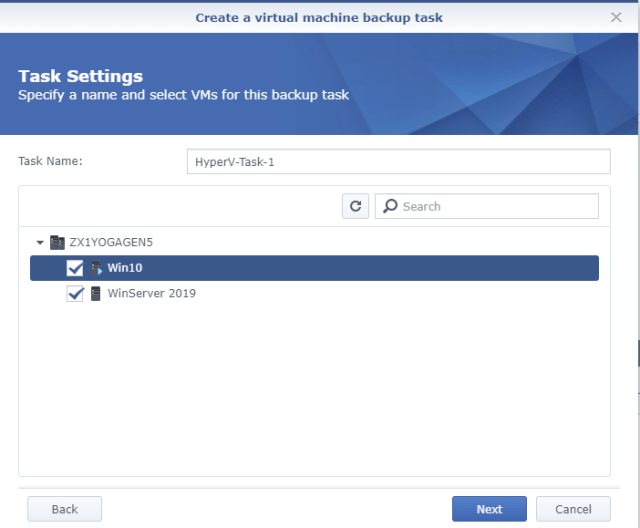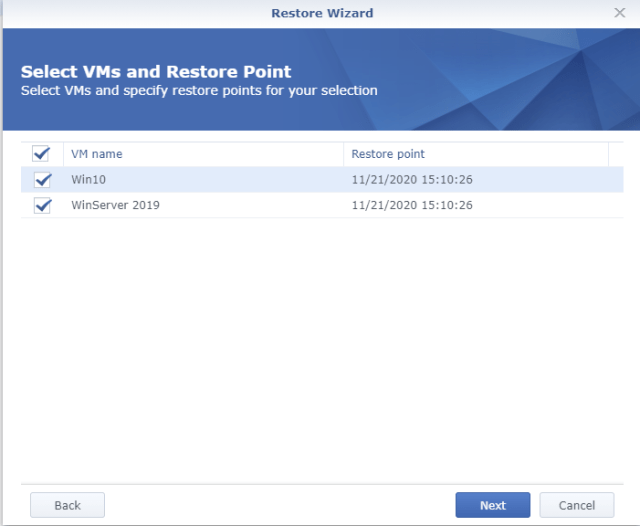Previously I’d already covered Synology’s Microsoft 365 Backup software which I was a big fan of, for simplicity of use and an incredibly cheap price point for a small to medium business as a Microsoft 365 data backup solution.
This time, I’m looking at Synology Active Backup for Business on their new DiskStation 1621xs+. Just like Microsoft 365 Backup, Active Backup for Business is free as long as you have a supported DiskStation model:
Applied Models
- 21 series:DS1621xs+, DS1621+, DVA3221
- 20 series:FS6400, FS3600, FS3400, RS820RP+, RS820+, DS1520+, DS920+, DS720+, DS620slim, DS420+, DS220+, SA3600, SA3400, SA3200D
- 19 series:RS1619xs+, RS1219+, DS2419+, DS1819+, DS1019+, DVA3219
- 18 series:FS1018, RS3618xs, RS2818RP+, RS2418RP+, RS2418+, RS818RP+, RS818+, DS3018xs, DS1618+, DS918+, DS718+, DS418play, DS218+
- 17 series:FS3017, FS2017, RS18017xs+, RS4017xs+, RS3617xs+, RS3617RPxs, RS3617xs, DS3617xs, DS1817+, DS1517+
- 16 series:RS18016xs+, RS2416RP+, RS2416+, DS916+, DS716+, DS716+II, DS416play, DS216+, DS216+II
- 15 series:RS815RP+, RS815+, RC18015xs+, DS3615xs, DS2415+, DS1815+, DS1515+, DS415+
- 14 series:RS3614xs+, RS3614RPxs, RS3614xs, RS2414RP+, RS2414+, RS814RP+, RS814+
- 13 series:RS10613xs+, RS3413xs+, DS2413+, DS1813+, DS1513+, DS713+
- 12 series:RS3412RPxs, RS3412xs, RS2212RP+, RS2212+, RS812RP+, RS812+, DS3612xs, DS1812+, DS1512+, DS712+, DS412+
- 11 series:RS3411RPxs, RS3411xs, RS2211RP+, RS2211+, DS3611xs, DS2411+, DS1511+, DS411+, DS411+II
The support goes a long way back years wise, which is great to see. They have a comprehensive overview of this application and it’s abilities, but I’ll cover it all more briefly here while sharing my experience setting each type of backup up.
Installing the software on a Synology DiskStation is easily done via Package Center and a very quick activation process that requires a free Synology account:

After activating, you’ll immediately see the overview screen. At a glance, it gives a good idea on the sorts of things you can back up:
PC and Physical Server backups
Backing up a physical PC or Server is pretty easy, and the wizard takes you through the steps. Windows 7 SP1 and above is supported, as is Windows Server 2008 R2 and above, and needs the ‘Synology Active Backup for Business Agent’ installed. After a next, next finish, install, you’ll need to specify the IP/name of your DiskStation, and username/password:

After connecting and confirming the details, the PC is registered against Active Backup for Business, and the agent continues to run in the tray:
The agent will show when you last backed up, and if a backup is currently running:

No backups will run yet though, because we need to create a backup task back on Active Backup for Business. Again, a wizard will take you through this and let you choose what options you’d like for backup. I’m going to just back up everything, with the data compression and encryption options (which are default)

You then define when you want your backup to run – manually, or on a schedule:

I do quite like some of the options here – backup by event of screen locked or signing out is a nice way of making sure it doesn’t interrupt someone using the PC and slow things down while they’re actually working. Also having backup windows, so you can block out the working day if needed.
Next is the retention policy, a good way of reducing space taken – is there a difference between a backup 5 months ago vs 5 months and 1 day? Probably not, and very unlikely that you had something worth restoring on your PC only for 1 day.

At the end of the wizard and a summary screen, you have the option to back up now. I kicked this off, and the agent immediately showed the progress and events related to backing up.

This was a really easy and painless setup to back up a PC, but what about restoring? You can either create recovery media for a full restore, or you can use the Restore Portal to navigate through backups and pick what you’d like to restore:
The bottom time line lets you pick from what point in time you’d like to restore, with a dot showing each available time point.
Then, you can navigate through the disk you need, and go through the folders which match the file structure at the time of backup. Once you’re on the single file, multiple files or folder you want to restore, you can choose the “Restore” option to put the files back in their original location, or somewhere else, and decide if you want to automatically overwrite existing files or not.
Download however, will just download the file you selected like any other browser based download, or multiple files will come through as a single ZIP file.
File Server Backups
If you don’t want, or can’t have an agent on a file share, you can instead remotely back up via SMB or rsync:

After entering the remote server details:

It will verify they work, then let you set up a task:

The options are Multi-versioned, Mirroring and Incremental. They cover the different scenarios you might want to use – Multi-versions will take up the most space, where mirroring can only ever be as big as the source files, and incremental is half way between the two, without the versioning component:

You can then choose what to back up in the file share:

And then finish creating your task by giving it a name, telling where to backup the files to locally, and set a schedule.

The other option you’ll notice here is ‘Enable CSS for SMB File Shares’. If the source share supports this, then the backup can be taken without interruption to access of these files, which has been fairly standard for a while – so turn this on if you can.
The restore process is pretty much the same as PC / Physical Server, so I won’t go into detail on that part.
Virtual Machine
Both VMWare Hypervisor and Microsoft Hyper-V are supported Virtual Machine platforms. As I haven’t touched VMware for years, we’ll look at Hyper-V only. It’s worth noting that cross platform restores are supported – you can restore a Hyper-V VM to VMware vSphere too.
Creating a Hyper-V backup is again an easy process:
First, you’ll need to put in the Hyper-V Host details. If you’re trying to back up VMs on a Windows 10 laptop you have, there’s a few small requirements:
Set up WinRM by running ‘WinRM QuickConfig’ in an elevated command prompt. You’ll need to make sure none of your network connections are set to ‘Public’.
Have a local admin account ready to use, and allow SMB2 through the Windows Firewall by allowing ‘File and Printer Sharing’ on Private networks.
The Hyper-V Backup Task wizard will give you hints as to where you might be stuck, and at the end you’ll have your host listed:

The Hyper-V Virtual Machines will then be automatically detected and listed, but they’re not configured for backup yet – we need another task. Clicking ‘Create Task’ will start by asking you where you want your backups:

Then you can choose the Hyper-V VMs to back up:

One selecting, we have several settings we can configure:

The default options are shown.
Maximum quantity of concurrent backup device(s) can be up to 10.
Enable Changed Block Tracking – Only transfer blocks that have changed since the last backup, rather than all blocks to reduce backup times drastically.
Enable application-aware backup – Use Volume Shadow Copy to ensure consistency with backups
Enable data transfer compression – Suggested for slow networks to improve transfer rates
Enable data transfer encryption – Self explanatory :)
Enable source datastore usage detection – to prevent running out of space
Enable backup verification – Checks the backup when complete
Once you’ve selected the options you want, you’ll see the familiar Schedule Backup Task window, retention policies etc:

I always prefer an agentless backup where possible, so it was good to see no agent was required to backup Hyper-V VMs.
Backing up a Windows Server 2019 VM was rather quick – especially since the laptop hosting the VM was connected via Wifi.

Restoring is again pretty simple, you can navigate to the location of the backups and see a copy of the vhdx for each VM, with other files I expect keep other incremental change data:
The Restore Wizard starts by letting you pick witch platform you’re restoring to- Synolgoy Virtual Machine Manager gives extended options for management and recovery and is recommended for flexibility in production environments. For a lab, you should be able to get away without it:

Restore Type – Instant Restore and Full Virtual Machine Restore are the two choices:

You can then pick which VMs you want to restore and which restore points:

Restore Mode lets you choose if you’re replacing the current live VM, or restoring to a different location as a copy:

Finally, the summary screen with the option of automatically powering on the VM when complete.

Phew! That’s the runthrough of the backup types and restore options Active Backup for Business supports.
The dashboard gives a great ‘at a glance’ overview of everything going on, and we even have de-duplication of data! This is what it looks like with some real data in it, compared to the first screenshot of this post:

There’s a bunch of other first party Synology apps available too:

Plus third party apps:

And with solutions like Docker, you can use your Synolgoy to host many other solutions available in containers, and run them off this little black box.
I’ll say the same thing about Synology Active Backup for Business I did in my Synology Microsoft 365 Backup Review – this is pretty impressive for ‘free’. Yes, you have to buy the Synology DiskStation itself, and you’ll need disks, but that’s it. Even if you use it as a single nightly backup for having a local and quickly accessible restore point to provide as much business continuity as possible, it’s an entire solution at an incredibly cheap price point.
Because you can do both Microsoft 365 data AND Hyper-V VMs on this single device, it should be an option that any small to medium business should investigate. The interface is easy to use, the logs show detailed information about what’s going on – and even for a home business setup, it’s very much a set and forget event.







